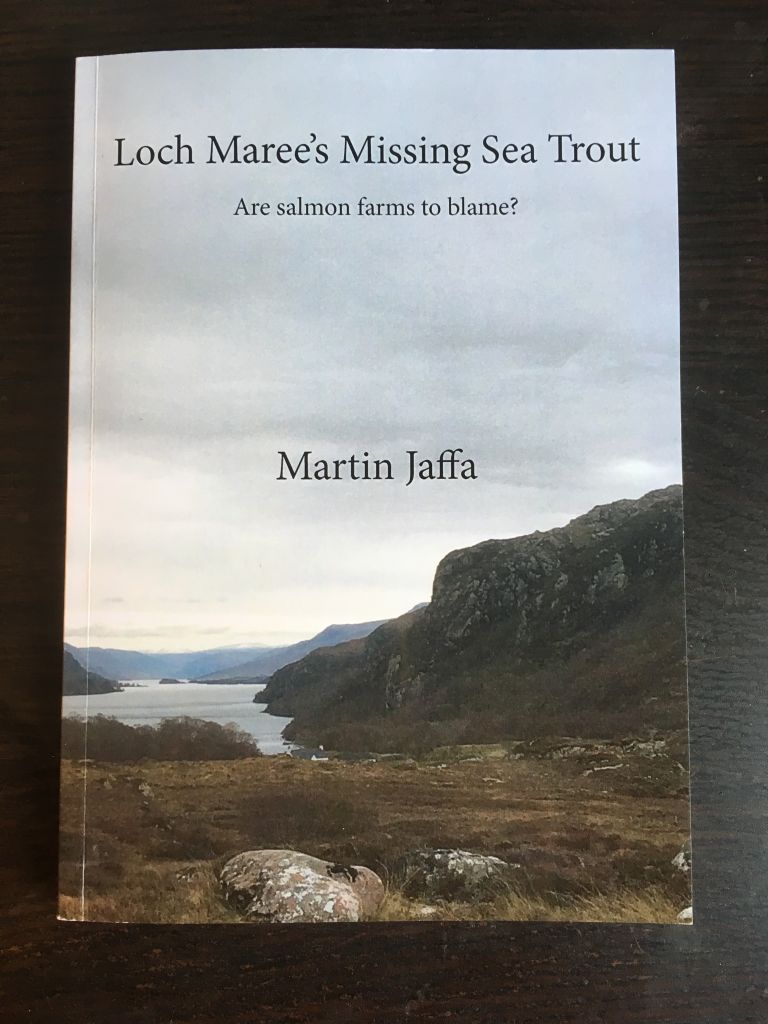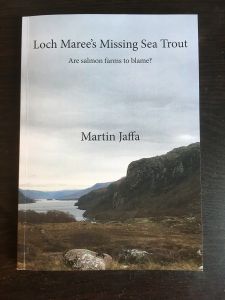A thoroughly good read: For many year, the wild fish sector has blamed the salmon farming industry for the decline in wild salmon and sea trout numbers caught from west coast rivers. This new narrative, Loch Maree’s Missing Sea Trout by Dr Martin Jaffa, explores the relationship between salmon farming and wild fish numbers and asks whether salmon farming is being unfairly blamed.
This new book takes a completely different look at this contentious issue but in an easy to read form. This is essential reading for anyone with an interest in the alleged impacts of salmon farming. The book is now available from either Amazon.com or Amazon.co.uk. This book comes highly recommended.
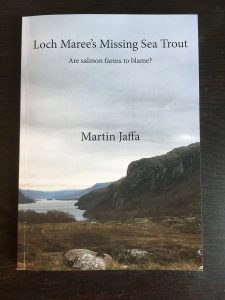
Enquiry: Since the Scottish Parliament’s Environment, Climate Change and Land Reform Committee published the SAMS review on the Environmental Impacts of Salmon Farming in Scotland, the Committee have held two sessions taking evidence. In all, the committee members took evidence from 12 different witnesses, of which only one spoke for the salmon farming industry. Given that the investigation concerned the impacts of salmon farming, there is a clear disparity between the eleven highlighting the negatives of salmon farming and the one speaking in its defence. We, at Callander McDowell, had written previously that we hoped that the investigation would be conducted in a fair and even-handed manner. We were wrong. This was more a witch hunt than an enquiry.
Having listened carefully to the questioning, we wonder how many of the committee members have actually visited a salmon farm, or whether instead they have relied on the press for their information. For example, one MSP described the fish as being packed into cages. With fish accounting for about 2% of the volume of the cage, this hardly reflects a description of being ‘packed in’. Maybe we’re wrong and the committee members know something about salmon farming that we don’t. We only hope that they have seen salmon farming first hand because it would be extremely questionable if they drew their conclusions based on the views of others and not their own.
However, regardless of whatever feelings each of the committee members have about salmon farming, the reality is that the salmon industry employs a large number of people in an area where job opportunities are extremely limited. Salmon farming has brought extensive investment into economically fragile areas of Scotland over a period of many years. Out of respect to these communities, the committee should have been willing to allow the salmon industry a fair hearing. Five different scientists from SAMS were given a full session to themselves in which to comment on the impacts of salmon farming. In return, the one representative invited to attend the committee was not even given the same length of time as SAMS and then had to share the session with two representatives from groups which are effectively against salmon farming.
We thought that given the extremely difficult circumstances and the none too friendly atmosphere. David Sandison from the SSPO spoke well. However, unlike the scientists from SAMS, he had no-one else to turn to. At the very least, the salmon industry should have been afforded a session to itself with its own panel of specialists and experts.
Trial by the One Show: The ECCLR inquiry spent a lot of time focussing on issues raised in the One Show TV programme. The programme was part on an onslaught of negative media coverage about salmon farming that began in 2017. The main source of this material was the full- time industry activist, Don Staniford. Most of his revelations originated from blanket Freedom of Information requests covering several years. This random trawl through the correspondence of government departments, paid for by Scottish tax-payers, produced a few stories that once he had twisted to suit his purpose of undermining the salmon industry, were readily snapped up by journalists ready to feed at his trough of free goodies.
Now it seems that the information has dried up as he has exhausted all possibilities of uncovering anything new. He is now advertising on his website for ideas for future FOI’s. We certainly have an idea. Perhaps, Mr Staniford could be free with information about who is paying for his activities and why?
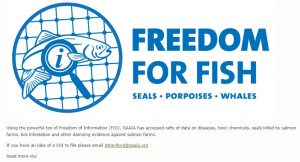
It has now been well established that since 2000, the US Charitable Foundations have poured $126 million into campaigns aimed at persuading US consumers to avoid buying imported farmed salmon and select wild caught salmon from Alaskan fisheries. The intention was to help protect the US way of life from imported seafood. The campaign, including messages such as Farmed & Dangerous’ ultimately failed because consumers actually liked eating farmed Atlantic salmon and because independent Canadian researcher Vivian Krause uncovered the secret funding to over thirty environmental groups tasked with helping spread the message.
Although the money mostly dried up, funds still flow to the persistent activists such as Mr Staniford. He’s not bothered as to whether west coast communities are destroyed as a result of his activities. He is simply out to ruin the salmon farming industry in Scotland.
First Evidence: The ECCLR Committee have posted some of the public submissions on their website but at the time of writing, these are few in number. The transcript of the second evidence session is also not due to be posted until the end of the week. We would like to discuss some of these submissions because they are factually incorrect. However, we would like to revert to the evidence submitted by the SAMS scientists during the first inquiry session.
On page 15 of the transcript, in a discussion about the number of lice that lead to the mortality of a fish, Professor Verspoor told the Committee that there is a location that he is familiar with but whose identity is not in the public domain has had historically high numbers of salmon even though those salmon have to go past a very large salmon farming operation. He continued that it would be difficult to say that the sea lice are having a negative impact given that the salmon in that location are at historical highs. He says that the river is stocked and therefore this could be the reason why there are so many salmon.
We find Professor Verspoor’s comments to be rather strange given that information about every river or fishery district is in the public domain. The river could be the River Lochy as this is stocked and the fish must pass salmon farms to migrate to sea. Equally, the River could be the Carron as we know that the University of the Highlands and Islands to which Professor Verspoor is associated has become involved with the long-term project there run by Dr Bob Kindness.
We have discussed the Carron over the years,but it is relevant now because the day after the recent session of the ECCLR Committee, BBC Alba broadcast the latest episode of their salmon angling programme – Turas a Bhradain. Over four series, the various episodes have not been favourable to the influence of salmon farming reflecting the views of many anglers. This latest episode looks at the relationship between the local farm and the River Carron fishery and we would hope that the Committee members might take seven minutes out of their schedule to watch the relevant section of the programme. This starts at about 15 minutes – https://www.bbc.co.uk/iplayer/episode/b09r2gbh/turas-a-bhradain-series-4-episode-5 (only in the UK). This will make a refreshing change from the continuing negative claims made by most of the evidence. For those, who are unable to watch the programme, amongst other things mentioned is that they have seen few lice despite the presence of a major aquaculture hub downstream. Dr Kindness said he personally caught 200 young sea trout whilst fishing of which only 10 carried any sea lice. If everything that the industry critics say was believed, then the west coast is a major environmental disaster and it’s not.
This is why organisations like Salmon & Trout Conservation focus on what is happening on farm rather than highlight the problems affecting the fish they claim to conserve. This is because the evidence they have of wild fish declines being linked to salmon farming is only circumstantial and therefore they deflect attention away from that onto the industry itself.
Interestingly, we note that the written evidence submitted to the Committee by Salmon & Trout Conservation – http://www.parliament.scot/S5_Environment/Inquiries/008_Salmon_and_Trout_Conservation_Scotland.pdf – runs to five pages and is not the four pages demanded by the committee. S&TC are not the only ones to ignore the Committee’s request to restrict evidence to four pages and we hope the Committee take note. We found it extremely difficult to limit our comments to just four pages, especially, using the large font and the justification found in the template. We took solace in fact that everyone was limited in the same way, but apparently some contributors believe that they are exempt. Perhaps, like submissions that arrive late, evidence that does not meet the Committee’s criteria should be rejected.
Second evidence: One of the frustrations of such inquiries is having to either listen to or read evidence that is known to be factually incorrect. As more submissions are published, it will no doubt become even more frustrating but to highlight our concern, we would like to take a look at the submission made by Doonfoot Fishing, which has been allocated the number 16.
The thrust of this submission is that twenty years ago the five-year average catch on this specific fishing beat reached 469 fish but in 2015, the catch was just 27 fish. The blame for this collapse is laid at salmon farming’s door since smolts migrating north from the River Doon must travel along the west coast aquaculture zone where it is claimed they pick up sea lice and consequently die. The fact that salmon farming has been around for forty years seems to have passed this contributor by. Why did the fishery not collapse twenty years ago? There were plenty of farms operating along the west coast then too.
The catch data for the whole river tells a very different story to that from this one beat.
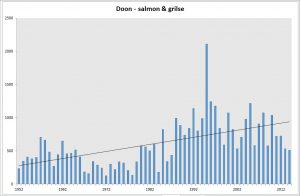
It can be clearly seen that catches on the Doon have improved significantly during the years after salmon farming arrived on the west coast. Yes, catches have declined in the last couple of years, but so have catches from the east coast rivers. There is a much wider problem affecting wild fisheries than salmon farming.
In this submission, Doonfoot Fishing also refer to closed containment. Specifically, comments made by Dr Hughes from SAMS. The submission states that ‘Dr Hughes stated that consumers were not in favour of buying salmon raised in closed containment, but the author of the submission is not aware of such evidence. Instead, reference is made to a major supermarket chain in Norway is selling salmon produced in closed containment and is selling it at a premium price. Such is demand, the supermarket is unable to source enough.
Given that this submission only ran to two pages, there was still plenty of space to expand on this statement. For example, which supermarket, where is the salmon produced and what sort of premium are they getting. The reason we mention this is that we are unaware of any supermarket selling such salmon in Norway at all. However, to be sure, we have been in contact with the seafood industry in Norway and no-one there is aware of any of this either. The Committee needs to request further details before accepting the validity of such information.
Closed containment is a contentious issue not least because whilst it is easy for critics to advocate a move to closed systems, the reality is that closed containment is still a long way off. Yes, there are examples of massive investment in large plants in the US, but they are still unproven.
Whilst giving evidence to the Committee, John Aitchison of the Friends of the Sound of Jura refers to a trial at Machrihanish run by a Norwegian company which he says has been concluded successfully. The success of any venture depends on the measure by which it is gauged. In the case of this trial, we wouldn’t describe it as a success since all the fish died. We are surprised given his proximity of the Friends of the Sound of Jura to Machrihanish, that Mr Aitchison wasn’t aware of this total fish kill. However, in our experience, most critics are very selective of the information they hear.
We are reminded of the campaign run by the Friends of the Sound of Jura against a new trout farm, in which one of the objections was the nearness of the proposed site to the River Add, one of the last good rivers for salmon in mid Argyll.
This claim about the River Add has always been of surprise to us at Callander McDowell. When we asked the late Bruce Sandison to provide the name of west coast rivers that had been destroyed by the presence of salmon farming as he claimed, the top of his list was the RIver Add.
When we plotted the historic catch data for catches of salmon from the River Add the graph shows that the fishery collapsed long before salmon farming arrived on the west coast.
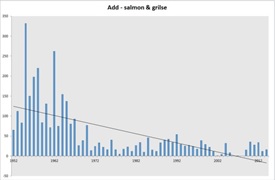
Does the river now offer good fishing as the Friends of the Sound of Jura Sound claim? The answer is no, which is why it is classified as a Grade 3 river. Perhaps, Mr Aitchison and his colleagues have a different perception of what is a good river to that of Marine Scotland?

